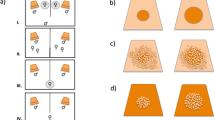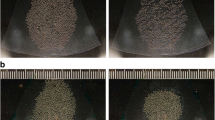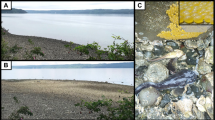Abstract
Convict cichlids (Cichlasoma nigrofasciatum) are substrate-brooding fish, native to Central America, with extended biparental care of young. Parents in the field and laboratory readily adopt foreign young of similar size to or smaller than their own, but usually reject larger foreign young. Under certain circumstances, the adoption of unrelated young has been shown to be adaptive to both donating and foster parents through (1) the dilution effect: the probability that their own young will be captured by a predator is reduced as the brood size increases; and (2) the differential predation effect: smaller young are more easily caught by brood predators than are larger young. These effects are not mutually exclusive. It has been demonstrated that parents of young with a standard length (SL) of 8 mm or bigger reject larger foreign young less often than do parents guarding smaller young, suggesting that the differential predation effect, and interfry aggression, may only be at work at smaller young sizes. In this study relative vulnerability of young to small gape predators (sub-adult conspecifics) decreased with increasing size of young (Fig. 1). When young were most vulnerable to predators (less than 8 mm SL) there was little or no benefit from dilution with larger young. However, as the young grew, the benefit of dilution with larger fry increased (Fig. 2).
Similar content being viewed by others
References
Baylis JR (1974) The behavior and ecology of Herotilapia multispinosa (Teleostei, Cichlidae). Z Tierpsychol 34:115–146
Coyne JA, Sohn JJ (1978) Interspecific brood care in fishes: reciprocal altruism or mistaken identity? Am Nat 112:447–450
Fraser SA, Wisenden BD, Keenleyside MHA (1993) Aggressive behaviour among convict cichlid (Cichlasoma nigrofasciatum) fry of different sizes and its importance to brood adoption. Can J Zool 71:2358–2362
Greenberg B (1963) Parental behavior and imprinting in cichlid fishes. Behaviour 21:127–144
Keenleyside MHA, Mackereth RW (1992) Effects of loss of male parent on brood survival in a biparental cichlid fish. Environ Biol Fishes 34:207–212
Lewis DSC (1980) Mixed species broods in Lake Malawi cichlids: an alternative to the cuckoo theory. Copeia 1980:874–875
McKaye KR (1981) Natural selection and the evolution of interspecific brood care in fishes. In: Alexander RD, Tinkle DW (eds) Natural selection and social behavior. Chiron, New York, pp 173–183
McKaye KR (1985) Cichlid-catfish mutualistic defense of young in Lake Malawi, Africa. Oecologia 66:358–363
McKaye KR, Hallacher L (1973) The Midas cichlid of Nicaragua. Pac Discovery 25:1–8
McKaye KR, McKaye NM (1977) Communal care and kidnapping of young by parental cichlids. Evolution 31:674–681
McKaye KR, Mughogho DE, Lovullo TJ (1992) Formation of the selfish school. Environ Biol Fish 35:213–218
Mrowka W (1987a) Brood adoption in a mouthbrooding cichlid fish: experiments and a hypothesis. Anim Behav 35:922–923
Mrowka W (1987b) Egg stealing in mouthbrooding cichlid fish. Anim Behav 35:923–925
Mrowka W (1987c) Filial cannibalism and reproductive success in the maternal mouthbrooding cichlid fish Pseudocrenilabrus multicolor. Behav Ecol Sociobiol 21:257–265
Myrberg AA (1964) An analysis of the preferential care of eggs and young by adult cichlid fishes. Z Tierpsychol 21:53–98
Neil SJ (1984) Field studies of the behavioral ecology and agonistic behavior of Cichlasoma meeki (Pisces: Cichlidae). Environ Biol Fish 10:59–68
Noakes DLG, Barlow GW (1973) Cross-fostering and parent-offspring responses in Cichlasoma citrinellium (Pisces, Cichlidae). Z Tierpsychol 33:147–152
Noble GK, Curtis B (1939) The social behavior of the jewel fish, Hemichromis himaculatus Gill Bull Am Mus Nat Hist 76:1–46
Ribbink AJ (1977) Cuckoo among Lake Malawi cichlid fish. Nature 267:243–244
Ribbink AJ, Marsh AC, Marsh B, Sharp BJ (1980) Parental behaviour and mixed broods among cichlid fish of Lake Malawi. S Afr J Zool 15:1–6
Ward JA, Wyman RL (1975) The cichlids of the respendent isle. Oceans 8: 42–47
Wisenden BD (1993) The reproductive ecology of convict cichlids in Costa Rica. Ph.D. thesis, University of Western Ontario, London
Wisenden BD (1994) Factors affecting reproductive success in free-ranging convict cichlids (Cichlasoma nigrofasciatum). Can J Zool 72:2177–2185
Wisenden BD, Keenleyside MHA (1992) Intraspecific brood adoption in convict cichlids: a mutual benefit. Behav Ecol Sociobiol 31:263–269
Wisenden BD, Keenleyside MHA (1994) The dilution effect and differential predation following brood adoption in free-ranging convict cichlids (Cichlasoma nigrofasciatum). Ethology 96:203–212
Yanagisawa Y (1985) Parental strategy of the cichlid fish Perissodus microlehis, with particular reference to intraspecific brood ‘farming out’. Environ Biol Fishes 12:241–249
Author information
Authors and Affiliations
Additional information
Communicated by G. Wilkinson
Rights and permissions
About this article
Cite this article
Fraser, S.A., Keenleyside, M.H.A. Why are larger convict cichlid (Cichlasoma nigrofasciatum) fry sometimes adopted into broods of smaller fry?. Behav Ecol Sociobiol 37, 343–347 (1995). https://doi.org/10.1007/BF00174139
Received:
Accepted:
Issue Date:
DOI: https://doi.org/10.1007/BF00174139




